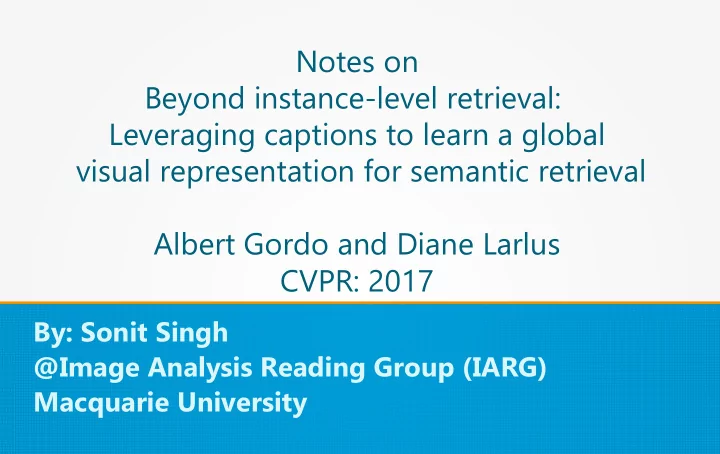

Notes on Beyond instance-level retrieval: Leveraging captions to learn a global visual representation for semantic retrieval Albert Gordo and Diane Larlus CVPR: 2017 By: Sonit Singh @Image Analysis Reading Group (IARG) Macquarie University
Motivation ● Existing Systems: – Text Based Image Retrieval – Content Based Image Retrieval ● Most of the research in image retrieval has focussed on the task of instance-level image retrieval, where the goal is to retrieve images that contain the same object instance as the query image. ● In this paper, authors – Move beyond instance-level retrieval and consider the task of semantic image retrieval in complex scenes.
Problem ● CBIR: Given a query image, retrieve all images relevant to that query within a potentially large database of images. ● Existing methods focused on retrieving the exact same instance as in the query image, such as particular object.
Overall Goal: Semantic Retrieval
Contributions ● Validated that the task of semantic image retrieval can be well-defined (because it is also highly subjective). ● Showed that a similarity function based on captions produced by human annotators, available at the training time, constitutes a good computable surrogate of the true semantic similarity. ● Developed a model that leverages the similarity between human- generated captions, to learn how to embed images in a semantic space, where the similarity between embedded images is related to their semantic similarity. ● Developed a model (extending previous one), that leverages the image captions explicitly and learns a joint embedding for the visual and textual representations.
Related Work ● Zitnick and Parikh showed that image retrieval can be greatly improved when detailed semantics is available.
Related Work... ● Image Captioning as a retrieval problem – First retrieve similar images, and then transfer caption annotations from the retrieved images to the query images.
Related Work... ● Joint embedding of image and text – Many tasks require to jointly leverage images and natural text, such as zero shot learning, language generation, multi- media retrieval, image captioning, and Visual Question Answering. – Common Solution: To build a joint embedding for textual and visual cues and to compare the modalities directly in that space.
Related Work: Joint embedding of image and text ● Deep Canonical Correlation Analysis (DCCA)
Related Work: Joint embedding of image and text ● WS-ABIE: Web Scale Annotation By Image Embedding
Related Work: Joint embedding of image and text ● DeViSE: Deep Visual Semantic Embedding Model – Learns a linear transformation of visual and textual features with a single-directional ranking loss
Related Work : Joint embedding of image a ● Using Bi-directional ranking loss
Related Work: Joint embedding of image and text ● Deep methods: Deep Multimodal Auto-Encoders
Related Work: Joint embedding of image and text ● Deep methods: CNN-RNN
Related Work: Joint embedding of image and text ● Deep methods: multimodal RNN (mRNN)
User Study: Dataset, Methodology and Inter-user Agreement ● Validating semantic search: Conducted a user study to acquire annotations related to the semantic similarity between images as perceived by users. ● Dataset: Visual Genome composed of 108k images, with a wide range of annotations such as region-level captions, scene graphs, objects, and attributeshttps://visualgenome.org/
User Study: Dataset, Methodology and Inter-user Agreement ● Methodology: – Involves 35 annotators (13 women and 22 men) – Manually ranking a large set of images according to their semantic relevance to a query image is a very complex, tidious, and time-consuming task. – To ease the task to annotators: Triplet ranking problem ● Given a triplet of images, composed of one query image and two other images, annotators were asked to choose the most semantically similar image to the query among the two option. ● To construct the triplets, authors randomly sample query images and then choose two images that are visually similar to the query. This is achieved by extracting image features using ResNet-101, pretrained on ImageNet. ● Two images are sampled from the 50 nearest neighbours to the query in the visual feature space. – Inter-user agreement : 87.3
User Study: Dataset, Methodology and Inter-user Agreement ● Agreement with Visual Representations
Proposed Methods
Experiments: Tasks ● To validate the representations produced by proposed semantic embeddings on the semantic retrieval task – Evaluated how well the learned embeddings are able to reproduce the similarity surrogate based on the human captions. – Evaluated proposed model using the triplet-ranking annotations acquired from users, by comparing how well visual embeddings agree with the human decisions on the triplets.
Experiments: Implementation ● Setup: – Visual model: ResNet-101 (pretrained on ImageNet), followed by the R-MAC pooling, projection, aggregation and normalization. – Textual features: Encoding the captions using tf-idf, after stemming using Snowball stemmer from NLTK – Batch size: 64 – Optimizer: ADAM – LR: 10*e-5 ● Metrics: Normalized Discounted Cumulative Gain (NDCG), and Pearson’s Correlation Coefficient (PCC) – PCC measures the correlation between ground-truth and predicted ranking scores – NDCG is the weighted mean average precision
Results and Discussion
Results and Discussion
Qualitative Results
Qualitative Results
Thanks
Recommend
More recommend